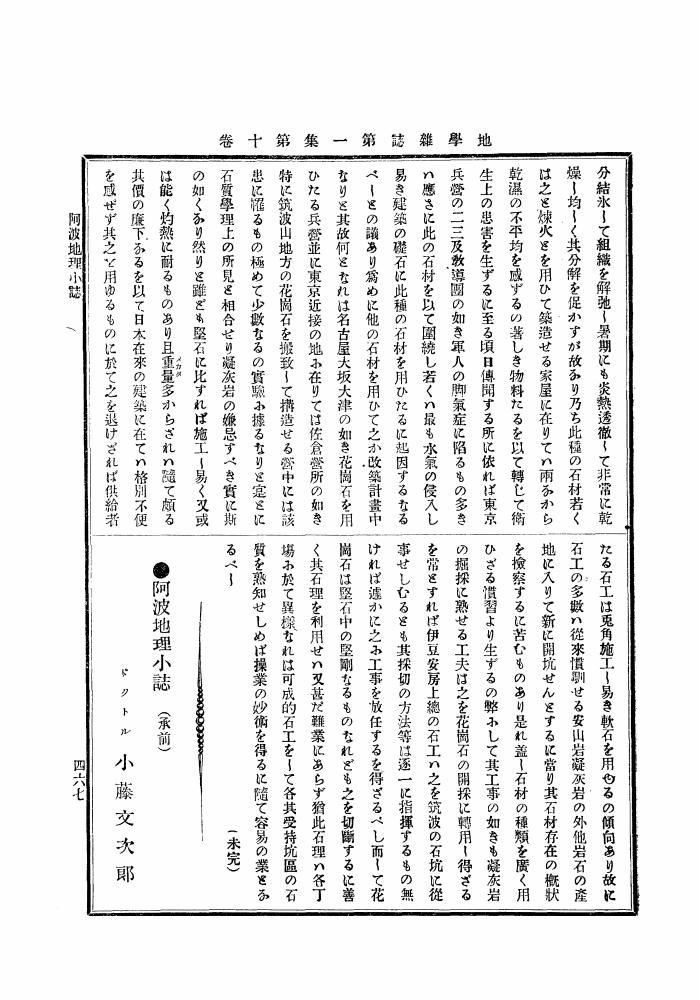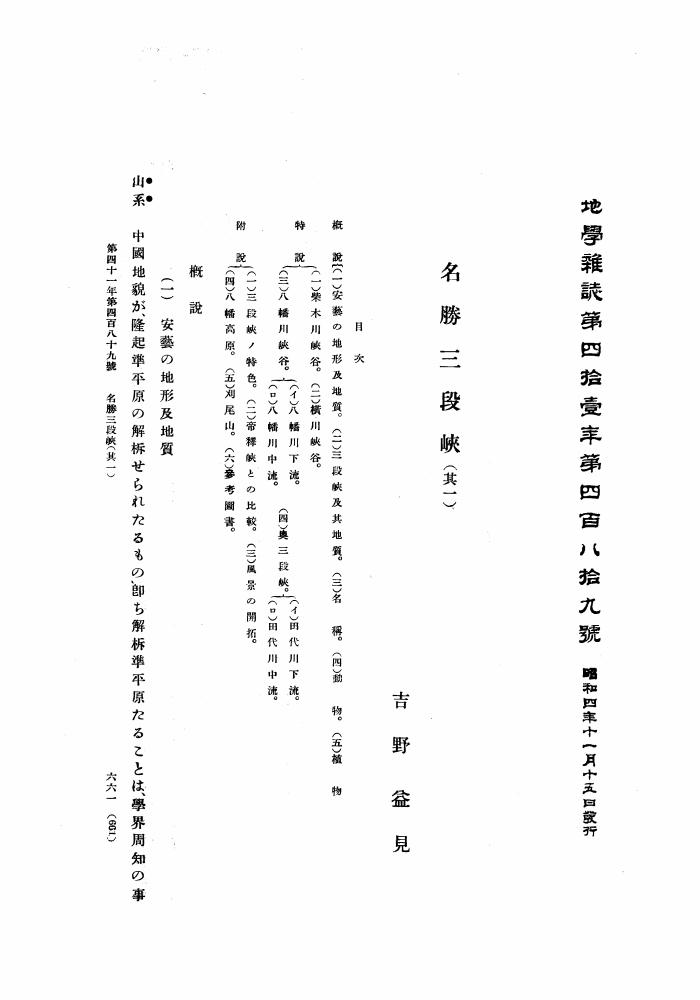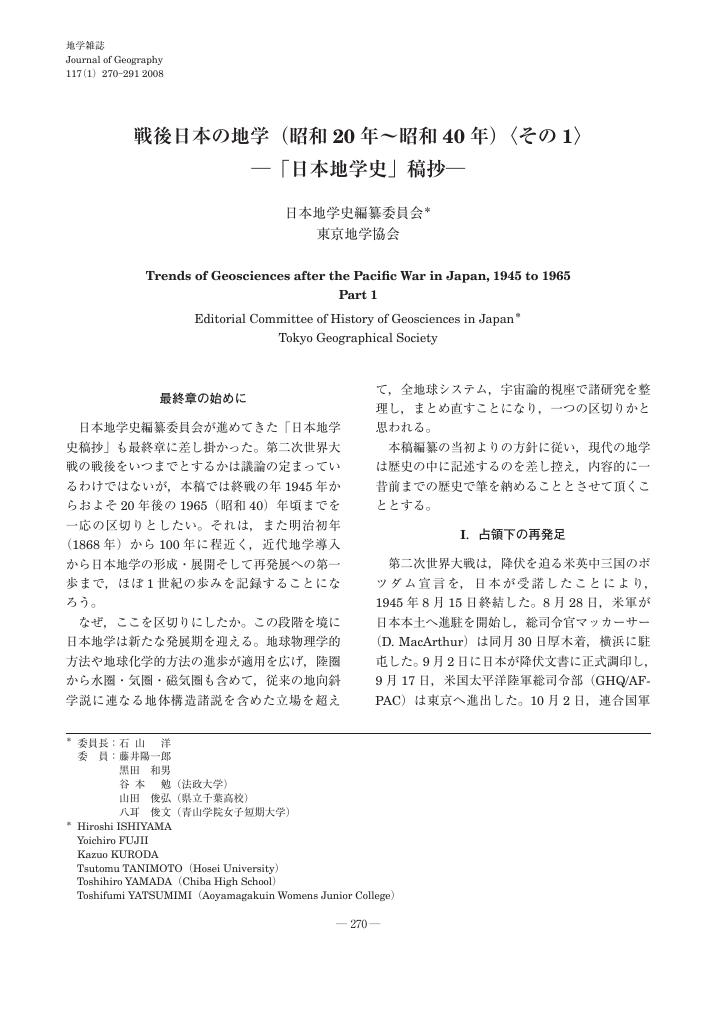1 0 0 0 OA 海洋モホ面形成におけるダナイトの役割
- 著者
- 小澤 一仁
- 出版者
- 公益社団法人 東京地学協会
- 雑誌
- 地学雑誌 (ISSN:0022135X)
- 巻号頁・発行日
- vol.117, no.1, pp.146-167, 2008-02-25 (Released:2010-02-10)
- 参考文献数
- 61
- 被引用文献数
- 8 8
The vicinity of the oceanic Mohorovicic discontinuity, transitional zone between the oceanic crust and mantle, is characterized by the common occurrence of dunite consisting mostly of olivine with small amounts of chromite. The most plausible formation mechanism of such dunite is believed to be an open-system reaction between pyroxene-bearing mantle peridotites, residues of partial melting, and basaltic silicate melts, partial melting products and the main ingredient of the oceanic crust. It is, therefore, important to specify the reaction stoichiometry and rates of influx and separation of basaltic melt involved in the reaction to better understand the formation mechanism of the transitional zone. Geological, petrological, and geochemical observations of ancient oceanic crust-mantle sections (ophiolites) and dredging and drilling of the current ocean floors provide key information for constraining the reaction processes. The status quo of studies on ophiolites and the ocean floor related to this subject is reviewed.
1 0 0 0 OA 阿波地理小誌
- 著者
- 小藤 文次郎
- 出版者
- 公益社団法人 東京地学協会
- 雑誌
- 地学雑誌 (ISSN:0022135X)
- 巻号頁・発行日
- vol.1, no.8, pp.347-354, 1889-08-25 (Released:2010-10-13)
1 0 0 0 OA 阿波地理小誌
- 著者
- 小藤 文次郎
- 出版者
- 公益社団法人 東京地学協会
- 雑誌
- 地学雑誌 (ISSN:0022135X)
- 巻号頁・発行日
- vol.1, no.9, pp.415-419, 1889-09-25 (Released:2010-10-13)
1 0 0 0 OA 阿波地理小誌
- 著者
- 小藤 文次郎
- 出版者
- 公益社団法人 東京地学協会
- 雑誌
- 地学雑誌 (ISSN:0022135X)
- 巻号頁・発行日
- vol.1, no.6, pp.241-248, 1889-06-25 (Released:2010-10-13)
1 0 0 0 OA 阿波地理小誌
- 著者
- 小藤 文次郎
- 出版者
- 公益社団法人 東京地学協会
- 雑誌
- 地学雑誌 (ISSN:0022135X)
- 巻号頁・発行日
- vol.1, no.7, pp.291-294, 1889-07-25 (Released:2010-10-13)
1 0 0 0 OA 阿波地理小誌
- 著者
- 小藤 文次郎
- 出版者
- 公益社団法人 東京地学協会
- 雑誌
- 地学雑誌 (ISSN:0022135X)
- 巻号頁・発行日
- vol.1, no.10, pp.467-471, 1889-10-25 (Released:2010-10-13)
1 0 0 0 OA 中部山岳地域における気象観測網の展開
- 著者
- 鈴木 啓助 佐々木 明彦
- 出版者
- 公益社団法人 東京地学協会
- 雑誌
- 地学雑誌 (ISSN:0022135X)
- 巻号頁・発行日
- vol.128, no.1, pp.9-19, 2019-02-25 (Released:2019-04-03)
- 参考文献数
- 10
- 被引用文献数
- 7 8
Mountainous areas are quite sensitive to global-scale environmental changes, such as warming. Therefore, the effect of global warming on these meteorological elements is a critical issue. However, Mt. Fuji Weather Station, which was once a symbol of meteorological observation in mountainous areas, has remained unmanned since August 2004. Of the other observation sites of the Japan Meteorological Agency, Nobeyama, at 1350 m.a.s.l. elevation, is the highest. When evaluating the effects of a global-scale warming event on regional-scale environmental change in the Japanese Alps at a high elevation of 1350 m.a.s.l., it must be noted that the lack of meteorological observation data at high elevations impedes any evaluations of the effects of warming on the ecological system and water resources in mountainous ranges. A network of 14 meteorological observatories has been developed by Shinshu University in the Japanese Alps, which have already started recording observations. The highest observation site is Mt. Yari, at 3125 m.a.s.l.. Observation data from these sites are sent to a computer at the laboratory via a data communication mobile telephone network or a phone line throughout the year. These meteorological observation data are available on the laboratory website in quasi-real time. The interannual variability of annual mean temperature and snow depth in the Japanese Alps region are discussed.
1 0 0 0 OA 名勝三段峡 (其三)
- 著者
- 吉野 益見
- 出版者
- 公益社団法人 東京地学協会
- 雑誌
- 地学雑誌 (ISSN:0022135X)
- 巻号頁・発行日
- vol.42, no.1, pp.40-52, 1930-01-15 (Released:2010-10-13)
- 参考文献数
- 20
1 0 0 0 OA 名勝三段峡 (其二)
- 著者
- 吉野 盆見
- 出版者
- 公益社団法人 東京地学協会
- 雑誌
- 地学雑誌 (ISSN:0022135X)
- 巻号頁・発行日
- vol.41, no.12, pp.777-788, 1929-12-15 (Released:2010-10-13)
1 0 0 0 OA 名勝三段峡 (其一)
- 著者
- 吉野 盆見
- 出版者
- 公益社団法人 東京地学協会
- 雑誌
- 地学雑誌 (ISSN:0022135X)
- 巻号頁・発行日
- vol.41, no.11, pp.661-676, 1929-11-15 (Released:2010-10-13)
1 0 0 0 OA 丹波と丹波西方域激び和歌山付近の地震活動の相関と兵庫県南部地震
- 著者
- 吉田 明夫
- 出版者
- Tokyo Geographical Society
- 雑誌
- 地学雑誌 (ISSN:0022135X)
- 巻号頁・発行日
- vol.104, no.6, pp.801-808, 1995-12-10 (Released:2009-11-12)
- 参考文献数
- 10
Correlation between seismic activities in the focal region of the Hyogo-ken Nanbu earthquake and in the surrounding regions were investigated. We found that seismic activity in the Tanba region had been well correlated with that of the Wakayama region, but the correlation has disappeared in 1990s. Activity to the west of Tanba region shows a tendency to be delayed to the activity in the Tanba region and this tendency is concordant with the f eature shown by Yoshida and Takayama (1992) that activity in the Mino region is advanced a few years against the activities in the Tanba and Wakayama regions. Such seismic correlations with time lags between surrounding areas of the Kinki triangle are considered to mean that tectonic stress in that district has a tendency to propagate or diffuse to the west at the velocity of 10 km/year. We present some evidence which decrease of the seismicity in the Tanba region in 1992-1993 period and increase in 1994 might be precursory changes for the Hyogoken Nanbu earthquake. Just after the Hyogo-ken Nanbu earthquake seismic activity in the Tanba region increased remarkably and an activity of small earthquakes was observed near the Yamasaki fault located to the west of the Hyogo-ken Nanbu earthquake. However, no unusual change of seismicity was seen in the Wakayama active region. Because a disastrous intraplate earthquake is likely to be followed by another large earthquake, and the most probable site of the succeeding large earthquake is the place where seismicity becomes active after the first earthquake (Yoshida and Ito, 1995), the Tanba region and its surrounding areas should be watched intensively in the following several to ten years.
1 0 0 0 OA 琵琶湖底掘削研究
- 著者
- 堀江 正治
- 出版者
- Tokyo Geographical Society
- 雑誌
- 地学雑誌 (ISSN:0022135X)
- 巻号頁・発行日
- vol.89, no.4, pp.213-236, 1980-08-25 (Released:2010-10-13)
- 参考文献数
- 6
Lake Biwa is the third oldest lake in the world next to Lake Baikal and C aspian and Aral Seas. Its peculiar position in the Japanese Archipelago, Deep Seated Earthquake zone, striking by negative gravity anomaly, and many endemic species of animals and plants indicate its extremely long limnetic history. In other words, if we succeed in obtaining whole sediments columns by deep boring, we can clarify many unknown facts such as glacial and interglacial features, geomagnetic events, cosmic ray variations, sedimentological phenomena, chemical composition, biological evolutions…cand so on.On the basis of this idea, the writers and their collaborators undertook deep coring operations of 200 meters at the water depth of 65 m at the center of the lake in 1971 and of 1, 000 meters at the shore in 1975-1976. This paper summarizes these results together with a discussion of our future project of extremely deep drilling in order to introduce our pioneering work of human beings.
1 0 0 0 OA 海底観測の新時代
- 著者
- 笠原 順三 白崎 勇一 川口 勝義 岩瀬 良一 中塚 正
- 出版者
- Tokyo Geographical Society
- 雑誌
- 地学雑誌 (ISSN:0022135X)
- 巻号頁・発行日
- vol.109, no.6, pp.920-933, 2000-12-25 (Released:2009-11-12)
- 参考文献数
- 29
To understand the Earth's geophysical phenomena, it is important to obtain multicomponent, continuous, long-range, and real-time marine data in global scale. To carry out observations in the sea, the most reasonable way at present is to use submarine cables for communication and power supply. There are cable projects using decommissioned submarine cables in Japan. GeO-TOC and VENUS projects. The H2O project is a US version of the VENUS project. Outlines of the two systems are presented with some new results.Some other projects using new fiber optic cables have been continued in Japan, but most of these projects are oriented toward seismic observations. The NEPTUNE and J-NEPTUNE projects are the most attractive projects in the near future to build multi-disciplinary observatories as Internet networks in the sea.
1 0 0 0 OA 能登邑智潟地溝帯
- 出版者
- 公益社団法人 東京地学協会
- 雑誌
- 地学雑誌 (ISSN:0022135X)
- 巻号頁・発行日
- vol.25, no.7, pp.521a-522, 1913-07-15 (Released:2010-12-22)
1 0 0 0 OA 戦後日本の地学(昭和20年~昭和40年)〈その1〉―「日本地学史」稿抄―
- 著者
- 日本地学史編纂委員会 東京地学協会
- 出版者
- 公益社団法人 東京地学協会
- 雑誌
- 地学雑誌 (ISSN:0022135X)
- 巻号頁・発行日
- vol.117, no.1, pp.270-291, 2008-02-25 (Released:2010-02-10)
- 参考文献数
- 102
- 被引用文献数
- 3 3
1 0 0 0 OA 地名舊稱保存
- 著者
- 石井 八萬次郎
- 出版者
- 公益社団法人 東京地学協会
- 雑誌
- 地学雑誌 (ISSN:0022135X)
- 巻号頁・発行日
- vol.3, no.2, pp.97-100, 1891-02-25 (Released:2010-10-13)
1 0 0 0 OA モホロビチッチの地震計
- 著者
- 磯崎 行雄
- 出版者
- 公益社団法人 東京地学協会
- 雑誌
- 地学雑誌 (ISSN:0022135X)
- 巻号頁・発行日
- vol.117, no.1, pp.268-269, 2008-02-25 (Released:2010-02-10)
- 参考文献数
- 3
- 被引用文献数
- 1 1
Andrija Mohorovičić (1857-1936) is a world-famous Croatian geophysicist and the discoverer of the Earth's crust/mantle boundary known as the Moho-discontinuity. The historical seismometer used by A. Mohorovičić to detect the Moho in 1909 is still maintained in working conditions, and is displayed in the Department of Geophysics of the University of Zagreb, Croatia, together with memorabilia from his office.
- 著者
- 丸山 茂徳 佐藤 友彦 澤木 佑介 須田 好
- 出版者
- 公益社団法人 東京地学協会
- 雑誌
- 地学雑誌 (ISSN:0022135X)
- 巻号頁・発行日
- vol.129, no.6, pp.757-777, 2020-12-25 (Released:2021-01-18)
- 参考文献数
- 28
- 被引用文献数
- 2
Reported are the origins and chemistry of hot spring water unique to the Ohmi–Hakuba region in the northern Japan Alps, central north Honshu, where a variety of rock types, derived from accretionary complex formed in the Ediacaran (presumably ca. 620 Ma), are regionally exposed. One of the largest bodies of serpentinized peridotite in Japan intersects the Quaternary volcanic front. Featuring an unusual geochemistry, the resulting unique hydrothermal hot springs yield a high pH (ca. 10-11) and a continuous supply of H2. Research reveals four types of hot spring in the Hakuba region: (1) serpentinite hosted hot spring water, (2) high-salinity and carbonated water, (3) Archean type low pO2 hot spring water, and (4) acidic and sulfuric hot spring water with a H2S gas input from magma. The high alkali and H2-enriched hot spring water (Type 1) differs remarkably from other hot springs in this region. In terms of geochemistry, there is a dissolved oxygen content due to the production of abundant H2, which is the reason why a Hadean-type microbial community is present. The origins and evolution of life are closely related to atmospheric oxygen level. Generally, anaerobic microbes inhabit subsurface areas where free oxygen is limited, while oxygen adaptive creatures cannot survive in an anaerobic environment. This means anaerobic microbes have not evolved, and remain as “living fossils”. Hakuba OD1 is one of the most important candidates for the oldest form of life directly connected to LUCA, because it has survived in a Hadean-like environment since emerging. The next research target is the ecosystem in a H2-enriched environment without free oxygen.
1 0 0 0 OA 生命の誕生と進化を駆動する外部エネルギー—自然原子炉と太陽—
- 出版者
- 公益社団法人 東京地学協会
- 雑誌
- 地学雑誌 (ISSN:0022135X)
- 巻号頁・発行日
- vol.129, no.6, pp.Cover06_01-Cover06_02, 2020-12-25 (Released:2021-01-18)
生命誕生の過程では,多種多様な生命構成単位(building blocks of life; BBLs)を合成するための強力な外部エネルギーが必要である.太陽エネルギーは化学進化を駆動するには弱すぎるうえ,夜間のエネルギー供給はゼロである.それゆえ他のエネルギー源が必要である.その有力な候補の一つが,冥王代地球表層に普遍的に存在していたと考えられる自然原子炉である.自然原子炉起源のウランの崩壊熱と電離放射線は前駆的化学進化において重要な役割を担う.電離放射線のように,十分な活性化エネルギーがコンスタントに確保されと,無機分子からより複雑な有機分子が合成されうる.こうした反応は,太陽光やマグマ由来の熱では到底不可能である.つまり,生命誕生へ向けた最初のプロセスは電離放射線が駆動したと考えられる.自然原子炉と間欠泉が組み合わさり物質・エネルギー循環系が形成されると,初期生命の誕生に向けたさまざまな反応が試行され,代謝と自己複製の機能がつくられたと推定される.間欠泉によって大気中に放出されたミクロンサイズの液滴飛沫が,もっとも原始的な細胞をつくりだし,より複雑化した膜やさまざまなBBLsの組み合わせをつくりだしたのであろう.さらに地上に放出された多種多様な原始細胞は,強力かつ豊富なエネルギー源である自然原子炉から離れたことが原因で,生き残りをかけて,やがて太陽光を利用する新たな機能を獲得したのであろう.表紙の画像は,生命進化を駆動する重要なエネルギー源である自然原始炉と太陽を対照的に描いたもので,地球と生命の誕生,共進化,未来を描いた12編からなるCG動画集「全地球史アトラス」1)の1シーンである.(丸山茂徳)Notes1) YouTube; https://www.youtube.com/c/冥王代生命学の創成 (in Japanese) or https://www.youtube.com/c/HadeanBioscience (in English) [Cited 2020/10/27].
1 0 0 0 OA 南アルプスにおける地形変動と土砂収支 ―最近の研究動向と展望―
- 著者
- 松岡 憲知 今泉 文寿 西井 稜子
- 出版者
- 公益社団法人 東京地学協会
- 雑誌
- 地学雑誌 (ISSN:0022135X)
- 巻号頁・発行日
- vol.122, no.4, pp.591-614, 2013-08-25 (Released:2013-09-11)
- 参考文献数
- 127
- 被引用文献数
- 5 6
This review paper synthesizes geomorphic dynamics, sediment transport and resulting natural hazards in mountains of the southern Japanese Alps and their drainage basins, where climatic and geological situations produce highly active landform dynamics. In alpine areas above the timber line, shallow diurnal freeze-thaw action operating in the thin topsoil produces small-scale periglacial forms, and gravitational spreading leads to numerous sackung features where snow-melt and heavy rain in places promote rockslides. In subalpine and montane areas, deep-seated landslides originate from fractured sedimentary rocks, deep V-shaped valleys, and heavy rain, while shallow landslides continue with historical forest clearance. Continuous slope failures prevent vegetation recovery and maintain debris input to valleys. Steep valleys contribute to high-density debris flows. Frequent or repetitive occurrences of these mass movements promote continuous denudation of slopes, rockfall accidents along hiking trails, and sedimentation at artificial dams. They occasionally cause significant hazards to villages further downstream. Predicting and mitigating slope hazards require distinguishing among annual, low-magnitude processes, episodic high-magnitude processes and geomorphic changes associated with long-term climate change.










